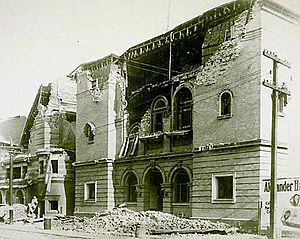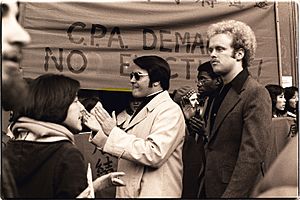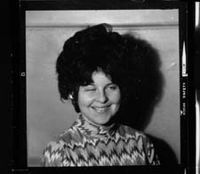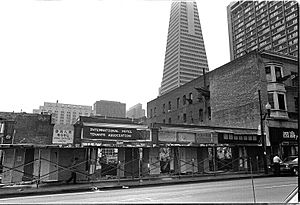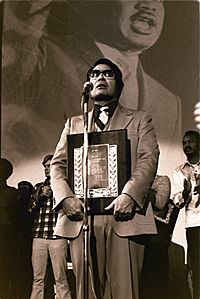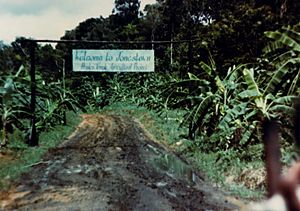Peoples Temple in San Francisco facts for kids
The Peoples Temple, the new religious movement, was headquartered in San Francisco, California, United States from the early to mid-1970s until the Temple's move to Guyana in 1977. During this period, the Temple and its founder, Reverend Jim Jones, rose to national prominence thanks to Jones' interest in social and political causes, and wielded a significant amount of influence in San Francisco's city government.
Contents
History
The Peoples Temple began in 1955 as a racially integrated Christian church founded by Reverend Jim Jones. While the Temple originated in suburban Indiana, the congregation moved to Redwood Valley, California in the late 1960s after Jones predicted a nuclear apocalypse that would facilitate the beginning of a socialist Eden on earth. By the mid-1970s, the organization possessed over a dozen locations in California, including in San Francisco and Los Angeles.
Its headquarters later moved into San Francisco, where Jones remained until July 1977, when he fled with almost 1,000 Temple members to the cult's remote settlement at Jonestown, Guyana following an investigative article in New West magazine.
San Francisco activities
When the Temple expanded its operations into the San Francisco Bay Area in the 1970s, its staff concentrated on advertising the organization's bus caravans to attract new converts.
In 1971, the Temple established a permanent facility in San Francisco at 1859 Geary Boulevard, an old building in the city's Western Addition that used to be a Scottish Rite temple; a Los Angeles facility followed two years later. The Temple purchased the Geary Boulevard building for $122,500 in 1972. While the Temple's Los Angeles facility initially attracted a larger, mostly African-American membership, the Temple later enticed hundreds of devoted Los Angeles members to move north to San Francisco to attend Temple meetings at Geary Boulevard.
By August 1975, Jones had completely abandoned prior plans to make Redwood Valley an internal "promised land." The reversal of the direction of Temple efforts from rural areas back into urban areas, where it had focused when located in Indiana, was complete. The liberal, counter-cultural stronghold of San Francisco better reflected the Temple's politics than conservative Indiana, and relocating to San Francisco permitted Jones and his followers to be open with their ideology.
However, Jones' faith healing ceremonies were problematic for the Temple, as they also drew some religious conservatives who were less likely to join a socialist organization. Because of this and the Temple's constant fear of conspiracies by outsiders opposing its message, new members were carefully screened.
Entrants to the Geary Boulevard facility were not permitted free access to the inner areas of the buildings. Rather, they were greeted by an amicable covert interrogation party that sized up visitors, with "suspicious" figures told to wait indefinitely in the lobby. The Temple assigned admitted attendees an "interpreter" of sorts to watch their reactions to the meetings and "explain" Jones' statements.
San Francisco Temple life
As the Temple shifted its focus to cities in the mid-1970s, communes became an important means of tightening controls and improving finances. Temple members in San Francisco were urged to live a communal lifestyle. Members elevated to the Temple's central governing body, the Planning Commission, were expected to "go communal." The money saved from communal living was to be donated to the Temple.
Children of Temple members would also be raised "communally," often in other Temple communes or through guardianships. The Temple stressed physical discipline.
The Temple converted some former real estate of its members into communal living units, and came to possess at least a dozen such locations scattered throughout San Francisco's Fillmore district. Communal members' possessions were sold through two Temple antique stores and through weekend flea markets.
Media alliances
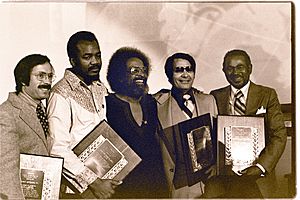
In 1972, Jones first met Dr. Carlton Goodlett, publisher of the San Francisco newspaper The Sun Reporter, which was targeted towards African-American readers. The two encountered each other at political rallies and at Goodlett's medical practice. The Sun Reporter soon thereafter presented the Temple with a "Special Merit Award."
The Temple and Goodlett soon forged an alliance, with Goodlett permitting the Temple to print its Peoples Forum newspaper on The Sun Reporter's presses. The deal was profitable for The Sun Reporter, and Jones and Goodlett entered into another media venture to invest and reorganize the Norfolk, Virginia newspaper The Journal and Guide. The Peoples Forum's first issue was published in 1973, with a large format issue first being published in 1976.
While Jones hoped to build the Peoples Forum into San Francisco's third largest daily paper behind the San Francisco Chronicle and San Francisco Examiner, and grossly exaggerated the circulation of the paper at "600,000", the paper only modestly grew to a circulation of closer to 60,000.
Jones also cultivated other media relationships. At the Chronicle, famed columnist Herb Caen was the Temple's most widely read media acquaintance, while city editor Steven Gavin attended Temple services along with a Chronicle reporter. Several reporters at local newspapers and television stations also spoke favorably of the Temple.
Political beginnings
Political volunteerism
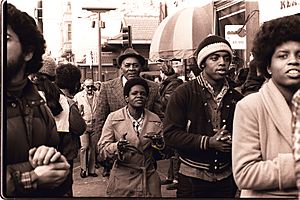
Several political developments in San Francisco in the mid-1970s, including a shift from citywide elections of county supervisors to district elections as well as campaign spending limits and reporting requirements, bestowed unprecedented power on local neighborhood groups and civil organizations such as the Peoples Temple. The organization began distinguishing itself with an overtly political message. It participated in political processes and formed alliances, not just for the sake of expediency, but also out of genuine political sympathies. As the ideological direction of the Temple became more openly socialist, it depended more upon the political world.
Jones made it known that he was interested in politics, and Corey Buscher, former press secretary to Mayor George Moscone, stated that he "made his followers available to support progressive Democratic candidates," though earlier Jones had also supported at least some local Mendocino County Republicans. However, the Temple played a double game of working underground among progressive circles, assuming the political establishment consisted of "corrupt enemies", while working publicly in traditional channels to advance its own causes.
Buscher explained that, soon after the Geary Boulevard facility opened, it "became common knowledge that if you were going to run for office in San Francisco, and your constituency included the black, the young or the poor, you'd better have Jones in your corner." The Temple had 3,000 registered members, though it regularly drew that same number to its San Francisco services alone, whether or not these were registered. Some more recent accounts state the effective membership numbered perhaps 8,000.
Of particular interest to San Francisco politicians was the Temple's ability to produce 2,000 people for campaign activities with only six hours notice. Buscher stated that Jones offered thousands of "foot soldiers" willing to walk precincts and get out the vote, which was "an offer no politician in his right mind could refuse." Similarly, Mayor Art Agnos stated that, "If you were having a rally for a presidential candidate, you needed to fill up the crowd, you could always get busloads from Jim Jones' church."
Agar Jaicks, who was chairman of San Francisco County's Democratic Central Committee, referred to the Temple as "a ready-made volunteer workforce." Jaicks further explained that Jones was "a man who touched a component of the consensus power forces in the city, such as labor and ethnicity groups, and he was very strong in the Western Addition. So here was a guy who could provide workers for causes progressives cared about."
Introductions
California State Assemblyman Willie Brown first met Jones at the Bardelli's restaurant in Union Square. Later, Jones sent Prokes to Brown's office to interview him, future District Attorney Joseph Freitas and future Sheriff Richard Hongisto for a Temple-produced documentary film.
Involvement in George Moscone's 1975 mayoral race
In San Francisco's 1975 mayoral race, Democratic candidate George Moscone ran against Republican John Barbagelata. During the race, Moscone held a meeting with Jones and Prokes requesting Temple volunteers to perform campaign work. Temple members subsequently saturated San Francisco neighborhoods, distributing slate cards for Moscone, Freitas, and Hongisto.
The Temple worked to get out the vote in precincts where Moscone received a 12-to-1 vote margin over Barbagelata. All three candidates won, with Moscone winning a close runoff by less than two percent of the vote. At the time of the election, a Moscone campaign aide stated, "Everybody talks about the labor unions and their power, but Jones turns out the troops."
After the election, Moscone and others believed that the Temple's efforts were instrumental in his close victory. A transcription of a phone conversation with Prokes one month later stated, "Moscone acknowledges in essence that we won him the election" and that "he promises J. an appointment."
Barbagelata and others suspected election fraud on the part of the Temple, believing that followers of Jones who were not San Francisco residents had been transported into the city to vote. After the mass killings at Jonestown in 1978, Temple members revealed to The New York Times that the Temple had indeed arranged for "busloads" of members to be driven from Redwood Valley to vote for Moscone. A former Temple member stated that many of those members were not registered to vote in San Francisco, while another former member said that "Jones swayed elections."
Yet another former member stated of Jones that "he told us how to vote", stating that Temple members were required to produce booth stubs to prove that they voted. When asked how Jones could know for whom they voted, the member responded, "You don't understand, we wanted to do what he told us to."
As San Francisco's newly-elected district attorney, Freitas set up a special unit to investigate the election fraud charges. Freitas named Temple member Timothy Stoen, whom he had hired as an assistant district attorney, to lead the unit. Stoen employed Temple members as volunteers to help with work on the investigation. The Temple was not mentioned in the proceedings that followed. After the tragedy, Stoen, who had turned against the Temple in 1977, stated that he was not aware at an election fraud effort by the Temple at the time, but that such a plot could have happened without his knowledge because, "Jim Jones kept a lot of things from me."
Help with Harvey Milk's 1976 race for the California State Assembly
Harvey Milk, who eventually became a member of the San Francisco Board of Supervisors, first became acquainted with the Temple while running for a seat in the California State Assembly against Art Agnos. Jones initially telephoned a Milk campaign worker and stated that he wished to back Milk, apologized for earlier backing Agnos, and said he would "make up for it" by sending volunteers to work on Milk's campaign.
When told by friend Michael Wong of Jones' earlier backing of Agnos, Milk retorted, "I'll take his workers, but that's the game Jim Jones plays." Temple member Sharon Amos organized the Temple's leafleting campaign for Milk. Amos requested the delivery of 30,000 pamphlets and Milk's campaign delivered them to the Temple.
Carter Administration encounters
After Jones' rise to political prominence in San Francisco, the Temple had a few meetings with members of the administration of President Jimmy Carter before the 1976 presidential campaign. During that campaign, Jones and Moscone met privately with Carter's running mate, Walter Mondale, on board his campaign plane at San Francisco International Airport. As soon as the encounter ended, Jones bandied it about to increase his standing with the government of Guyana, claiming he and Mondale engaged in private talks regarding outside attempts to destabilize the country.
In the fall of 1976, Jones and First Lady Rosalynn Carter both spoke at the grand opening of the San Francisco Democratic Party Headquarters. Temple members packed the audience, and Jones garnered louder applause when he spoke than Mrs. Carter. Mrs. Carter also met Jones for a private dinner at the Stanford Court Hotel, photos of which were printed in the Peoples Forum newspaper.
Mrs. Carter later telephoned Jones personally, unaware that the Temple was taping her conversation. President Carter also sent a representative to a dinner at the Temple at which Jones and then-Governor Jerry Brown spoke. Jones and Mrs. Carter dined again in March 1977 and exchanged letters afterward. In one of these letters, Jones requested aid for Cuba, having recently met dictator Fidel Castro.
In a handwritten reply to Jones on White House stationery, Carter wrote, "Your comments on Cuba have been helpful. I hope your suggestion can be acted on in the near future." Carter also wrote that, "I enjoyed being with you during the campaign -- and do hope you can meet Ruth soon."
However brief their encounters, the Temple did receive some limited praise from administration members. In 1976, Mondale stated regarding the Temple that "knowing the congregation's deep involvement in the major social and constitutional issues of our country ... is a great inspiration to me." Carter's Welfare Secretary, Joseph Califano, stated to Jones that "your humanitarian principles and your interest in protecting individual liberty and freedom have made an outstanding contribution to furthering the cause of human dignity."
The San Francisco Housing Authority Commission
In March 1976, Mayor Moscone appointed Jones to the Human Rights Commission. Without telling his aides, just minutes before being sworn in, Jones declined the appointment, feeling it was a lateral move because he had served on a similar commission in Indiana in the 1960s. The aides of Moscone and Jones then scrambled to tell the media that Jones and Moscone were working on an alternative appointment.
Thereafter, Moscone appointed Jones as a member of the San Francisco Housing Authority Commission. After Jones' name appeared on the appointment list, the San Francisco Board of Supervisors requested that all potential appointees should receive background checks. Moscone then turned the matter over to a nominating committee that included Prokes and Goodlett. The committee approved Jones' appointment. When potential resistance arose to Jones' appointment, Willie Brown introduced legislation that would have stripped the Board of Supervisors of its power over the appointment. Wishing to maintain the status quo, the Board unanimously approved Jones' appointment.
After lobbying by Moscone's office, Jones was soon named Chairman of the Commission. At the time, Moscone stated that Jones was a "peacemaker ... who had the ability to work with people." In July 1977, after media investigations into the Temple had begun, Moscone defended the appointment stating Jones was "both sensitive and realistic. From everything I've seen, he's been a good chairman."
Jones' most notable accomplishment on the Commission was to lead the fight for a period against the eviction of impoverished residents at the International Hotel by the Four Seas Corporation. With Jones as Chairman, the Housing Authority voted to acquire the building using $1.3 million in federal funds in order to transfer ownership to tenants rights groups.
When a federal court rejected the plan and ordered evictions in January 1977, the Temple provided 2,000 of the 5,000 people that surrounded the building, barricaded the doors and chanted, "No, no, no evictions!" Sheriff Hongisto, a political ally of Jones, refused to execute the eviction order, which resulted in him being held in contempt of court and serving five days in his own jail.
Political activities at the Temple
While the Temple aided some local politicians, it did not do so entirely without suspicion. Milk privately felt that Temple members were odd and dangerous. When a Milk aide became wary of the Temple's large and imposing security force following a delivery of election pamphlets, Milk cautioned the aide: "Make sure you're always nice to the Peoples Temple. If they ask you to do something, do it, and then send them a note thanking them for asking you to do it. They're weird and they're dangerous, and you never want to be on their bad side." Jim Rivaldo, a political consultant and associate of Milk, said that, after later meetings at the Temple, he and Milk agreed that "there was something creepy about it."
However, many politicians spoke at Geary Boulevard, including Milk and Governor Jerry Brown. By mid-1977, Willie Brown had visited the Temple perhaps a dozen times, some by invitation and some on his own. Preliminary consideration was even given by Brown's administration to a statewide post for Jones before his flight to Guyana.
Governor Brown, Willie Brown, Moscone, Dymally, Freitas, and Republican State Senator Milton Marks, were among the attendees of a large testimonial dinner in Jones' honor in September 1976. Willie Brown served as master of ceremonies and introduced Jones, stating, "Let me present to you what you should see every day when you look in the mirror in the early morning hours ... Let me present to you a combination of Martin King, Angela Davis, Albert Einstein ... Chairman Mao."
At another testimonial dinner, Brown introduced Jones, referring to him as "a young man came upon the scene, became an inspiration for a whole lot of people. He’s done fantastic things." Dymally stated that Jones was bringing together all ages and races and stated that "I am grateful he is showing an example not only in the U.S. but also in my former home territory, the Caribbean." At another testimonial dinner, when Jones garnered huge applause from the thousands attending, Moscone stated, "You know I’m smarter than to give a speech after listening to Reverend Jim Jones" and "there are two people I’m glad I’m not running against, Cecil Williams and Jim Jones".
Similarly, Milk was enthusiastically received at the Temple several times during his visits, and he always sent glowing notes of gratitude to Jones after visits. Milk ally Richard Boyle recalls "[b]oth Milk and I spoke at the temple to the cheers of thousands of Jones' followers and won their support." Following one visit, Milk wrote to Jones: "Rev Jim, It may take me many a day to come back down from the high that I reach today. I found something dear today. I found a sense of being that makes up for all the hours and energy placed in a fight. I found what you wanted me to find. I shall be back. For I can never leave."
In another hand-written note, Milk wrote to Jones: "my name is cut into stone in support of you - and your people." Jim Rivaldo, who attended Temple meetings with Milk, explained that, until Jonestown, the church "was a community of people who appeared to be looking out for each other, improving their lives." Boyle explained that it was vital for both his campaign and Milk's that they be received well at the Temple "because Jones was not only Moscone's appointed head of the Housing Authority but also could turn out an army of volunteers."
In an interview of Jones by Willie Brown for a television show about the Temple, Brown stated, "You've managed to make the many peoples associated with the Peoples Temple a part of a family. If you're in need of health care, you get health care. If you're in need of legal assistance of some sort, you get that. If you're in need of transportation, you get that."
On another occasion, Brown stated, "San Francisco should have ten more Jim Joneses." Although Brown praised Jones, Jones in turn detested Brown for indulging in sports cars, clothes and women. During one of Brown's addresses at the Temple, Jones sat behind Brown and flipped his middle finger into the air.
While the Temple received political guests, Jones used his relationship with Moscone to intimidate potentially disagreeable Temple members. For example, former member Deborah Layton stated that her thoughts of running away were quashed by Jones' threats, including his statement: "Don't think you can get away with bad-mouthing this church. Mayor Moscone is my friend and he'll support my efforts to seek you out and destroy you."
Media investigation and exodus
In 1976, despite the Temple's newly acquired political might and upgraded image, high visibility had heightened Jones' fears of government crackdowns and media scrutiny. In April of that year, through harassment of newspaper personnel by way of numerous phone calls and letters, Jones was able to prevent Chronicle reporter Julie Smith from publishing an unfavorable story on the Temple. Fellow Chronicle reporter Marshall Kilduff wished to do a story on the Temple, but became reluctant after witnessing the Temple's treatment of Smith. Kilduff wondered how Jones had somehow learned the exact contents of Smith's article before it had come out.
When touring the Temple, Kilduff noticed, much to his surprise, that Chronicle city editor Steve Gavin and reporter Katy Butler were in attendance. The Temple's Peoples Forum newspaper chided Kilduff for not having a venue for his story and stated that he was "trying to convince different periodicals that a 'smear' of a liberal church that champions minorities and the poor would make 'good copy.'" Rather than dropping his story, Kilduff took it to New West magazine.
The Temple conducted another harassment campaign against New West, its advertisers, and owner Rupert Murdoch. The magazine received fifty calls and seventy letters a day before the article was even published. Concerned about the potential fallout from Kilduff's article, which included testimonies from Grace Stoen and Joyce Shaw, prompted Jones to decide on relocating the Temple to Jonestown. Jones convened with top aides for four days to formulate a plan for the exodus.
In its final form, Kilduff's article contained numerous allegations of fraud. Just before its publication in July 1977, Moscone urged an ally who was the chairman of a department store chain to call friends at New West to inquire about the contents of the article. Jones fled to Guyana the night that the contents were read to him over the phone.
While Jones' exit was hasty, the exodus of most Temple members had been carefully prepared. The San Francisco field office of Immigration and Naturalization Service (INS) received hundreds of requests for passports in the weeks before the New West article was published.
After the New West article broke, San Francisco Supervisor Quentin Kopp immediately demanded that Moscone and Freitas launch an investigation into the Temple's activities. Moscone's office issued a press release stating, "The Mayor's Office does not and will not conduct any investigation" because the article was "a series of allegations with absolutely no hard evidence that the Rev. Jones has violated any laws, either local, state or federal."
After a six-week inquiry by the special unit, formerly headed by Timothy Stoen, Attorney Freitas' office authored a report stating that the investigation turned up "no evidence of criminal wrongdoing", though it stated that the Temple's practices were at best "unsavory". Freitas did not publicly disclose either the investigation or the report.
Following the publication of media reports alleging criminal wrongdoing, Guyanese Minister of State Kit Nasciemento contacted Freitas and was told that the case against Jones was closed.
After Jones' move to Guyana
A temple without a leader
As the time after Jones' departure proceeded, the zealotry of the San Francisco staff turned to martyrdom. Friday and Sunday meetings were still held, but attendance dropped. With donations in decline, the Temple began to sell off its property. With shrinking personnel, the staff that remained became overworked. While the Geary Boulevard facility eventually became little more than a supply depot for Jonestown, the Temple insisted in a press release that "we are not moving out of San Francisco or California", denouncing news reports of a permanent exodus as "biased and sensationalistic reporting."
San Francisco media, such as the San Francisco Examiner, monitored communications that Jones made from Jonestown back to Geary Boulevard via shortwave radio. Much of them contained mundane requests interspersed with Jones' usual propaganda. Many in the San Francisco Temple feared that the Federal Communications Commission (FCC) would revoke the Temple's radio license, cutting its lifeline to Jonestown.
Complicating matters, Jones made impossible demands on the now skeletal staff, including writing 1,500 letters to the FCC and 1,500 to the Internal Revenue Service. Any members that were seen as wavering were sent to Jonestown. Meanwhile, former Bay Area Temple allies, such as Angela Davis and Huey Newton, broadcast live radio messages to the inhabitants of Jonestown during Jones' fiery "White Night" rallies, telling Temple members to hold strong against the "conspiracy."
The Temple hired Charles R. Garry to represent it in numerous lawsuits and to draft Freedom of Information Act requests. The Temple also hired noted JFK assassination conspiracy theorist Mark Lane, who gave press conferences at the Geary Boulevard facility.
In October 1978, a crippling blow occurred when San Francisco Temple leader Terry Buford defected, though she wrote a series of notes falsely claiming that she was going under cover as a "double agent" to infiltrate "Timothy Stoen's group." Buford had secretly gone to stay with Lane, whom she had met during interactions at Geary Boulevard.
Waning political clout
While most influential allies broke ties with the Temple following Jones' departure, some did not. Willie Brown stated that the attacks were "a measure of the church’s effectiveness", while Herb Caen wrote a column in the Chronicle questioning the validity of the New West article. The Sun Reporter also defended the Temple.
On July 31, 1977, just after Jones had fled to Guyana, the Temple conducted a rally against political opponents attended by Brown, Milk and Agnos, among others. At that rally, Brown stated, "When somebody like Jim Jones comes on the scene … and constantly stresses the need for freedom of speech and equal justice under law for all people, that absolutely scares the hell out of most everybody … I will be here when you are under attack, because what you are about is what the whole system ought to be about!" Brown also stated of Jones at the rally that "[h]e is a rare human being" and "he cares about people … Rev. Jim Jones is that person who can be helpful when all appears to be lost and hope is just about gone."
While Moscone refused a request to launch his own inquiry, he was deeply disturbed by the allegations against the Temple, though he thought Jones would return from Guyana. However, on August 2, 1977, Jones dictated his resignation from Guyana via radio-telephone.
Milk remained popular among Temple members. Two months before the Jonestown tragedy, Temple members sent over fifty letters of sympathy to Milk following the death of his lover, Jack Lira. The letters were formulaic and one typical letter ended, "You have our deepest sympathy in your loss and we would be glad to have you with us [in Jonestown], even for only a short visit."
Temple member Sharon Amos wrote, "I had the opportunity in San Francisco when we were there to get to know you and thought very highly of your commitment to social actions and the betterment of your community." She also wrote, "I hope you will be able to visit us here sometime in Jonestown. Believe it or not, it is a tremendously sophisticated community, though it is in a jungle."
Milk spoke at a service at the Temple for the last time in October 1978. After Congressman Ryan announced that he would investigate Jonestown following the 1978 midterm elections, Brown was still planning a fund raising dinner for the Temple that was to be held on December 2.
San Francisco media and the Concerned Relatives
In San Francisco, Jones suffered further damage from unfavorable media articles during his absence. Especially damaging was a February 18, 1978 article in the Examiner, following a telephone interview with Jones, which detailed the custody fight over John Stoen and pressure for a congressional investigation of Jonestown spearheaded by John's father Tim, the leader of the Concerned Relatives. The repercussions of the article were devastating for the Temple's reputation, and made most former supporters even more suspicious of the group's claim that they were being subjected to a "rightist vendetta." The Examiner article also drew the interest of Congressman Ryan, who had weeks earlier been lobbied by Timothy Stoen and wrote a letter on his behalf.
The next day, on February 19, Milk wrote a letter to President Carter supporting Jones and made statements about the Stoens. Milk wrote that "Rev. Jones is widely known in the minority communities and elsewhere as a man of the highest character." Regarding Timothy Stoen, Milk wrote that "[i]t is outrageous that Timothy Stoen could even think of flaunting this situation in front of Congressman with apparent bold-faced lies." The letter ended with, "Mr. President, the actions of Mr. Stoen need to be brought to a halt. It is offensive to most in the San Francisco community and all those who know Rev. Jones to see this kind of outrage taking place."



